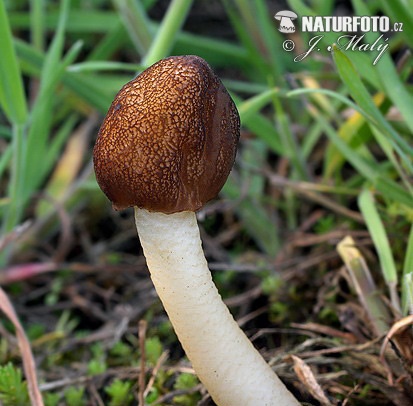Thimble Morel: Red Data Book of Armenia

Category. VU– Vulnerable.
Brief description. Fruit bodies are up to 10 cm high, straight. Cap is 1–3 x 1–1,5 cm across. The upper part is light brown, the lower part is white, thimble–like, bell–shaped or egg–shaped, slightly wavy or folded with free margins. Flesh is thin, candle–like without any specific taste or smell. Stipe is 5–10 x 1–1,5 cm, whitish, light yellowish, with mealy surface, very brittle. Sporosacs (asci) are cylindrical and contain 8 spores. Paraphysis are up to 10 µm, brown, filamentous, widened at the top. Spores are 20–25 x 12–18 µm, colourless, globose or ellipsoid, smooth.
Distribution. Generally in Europe, Asia, Northern America, Southern Caucasus (Georgia, Armenia). In Armenia it is discovered in Yerevan floristic region – in "Khosrov" State Reserve; in Zangezur floristic region.
Ecological, biological and phytocenological peculiarities. In Armenia it is rarely met, mainly in unique individuals on the soil, in broad–leaved forests, on the altitude of 1300–1900 m above sea level, in May–June. Saprotrophic fungi on humus. Fruit bodies are conditionally edible.
Main factors of endangering. Degradation and breakdown of ecosystems, reduction of forest areas caused by uncontrolled felling.
Nature conservation measures. In Armenia it is conserved in corresponding ecosystems of "Khosrov" State Reserve. It is necessary to carry out monitoring of the state of discovered species and discovery of new habitats.
Suggestions
 The Ministry of Environment sent a letter international partners to draw their attention to the real danger of environmental disasters as a result of Azerbaijan's large-scale aggression towards the territory of Armenia
The Ministry of Environment sent a letter international partners to draw their attention to the real danger of environmental disasters as a result of Azerbaijan's large-scale aggression towards the territory of Armenia
 Vicia pisiformis: Red Data Book of Armenia
Vicia pisiformis: Red Data Book of Armenia
 Vavilovia formosa: Red Data Book of Armenia
Vavilovia formosa: Red Data Book of Armenia
 Trigonella capitata: Red Data Book of Armenia
Trigonella capitata: Red Data Book of Armenia
 Trigonella astroides: Red Data Book of Armenia
Trigonella astroides: Red Data Book of Armenia












